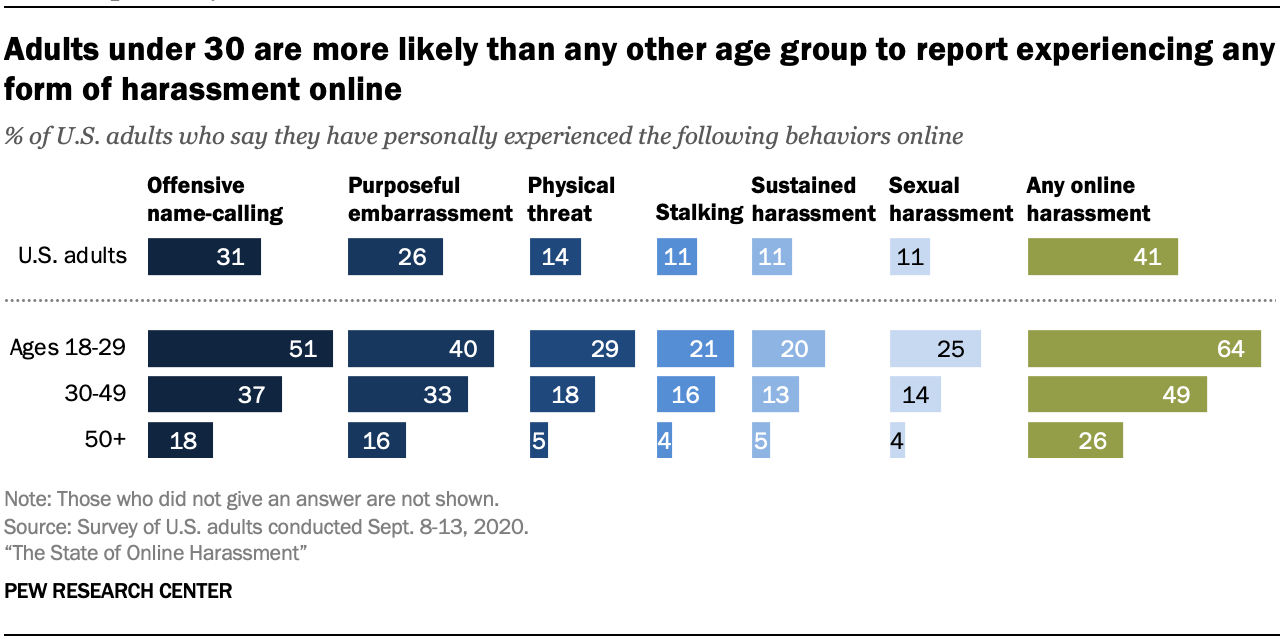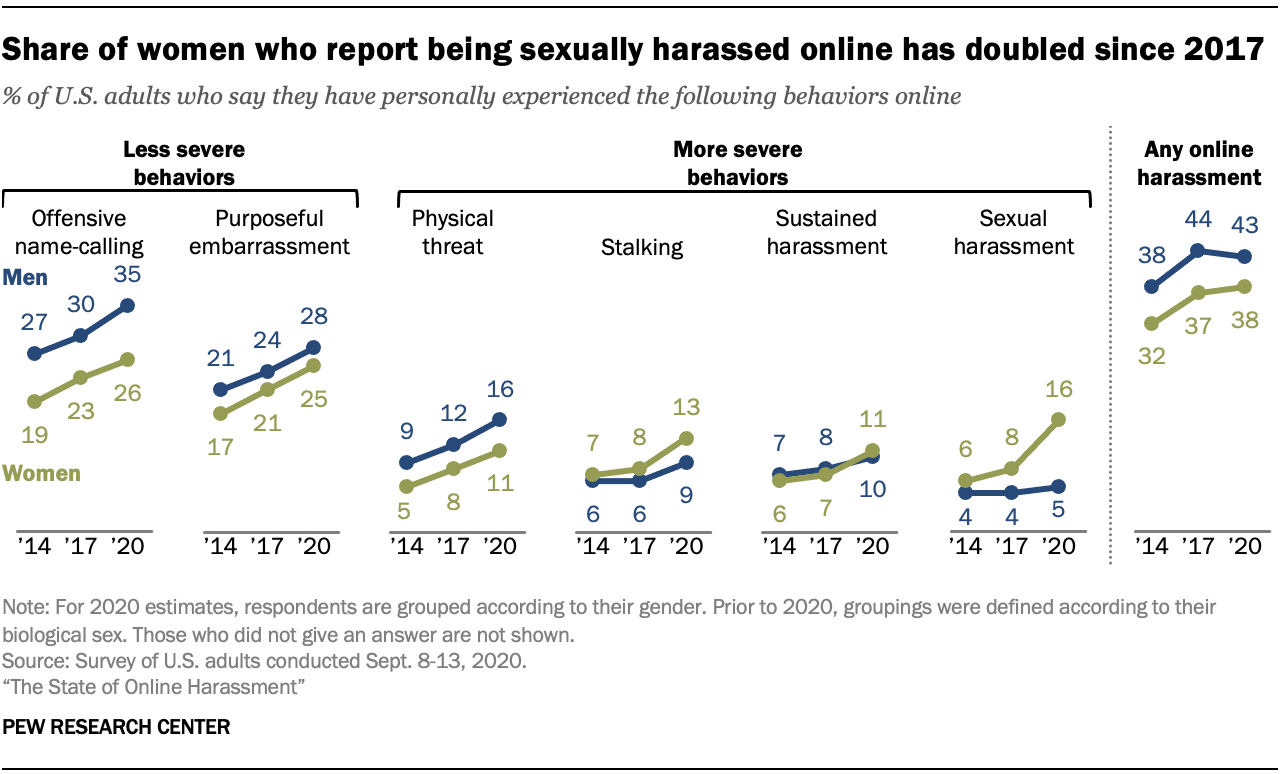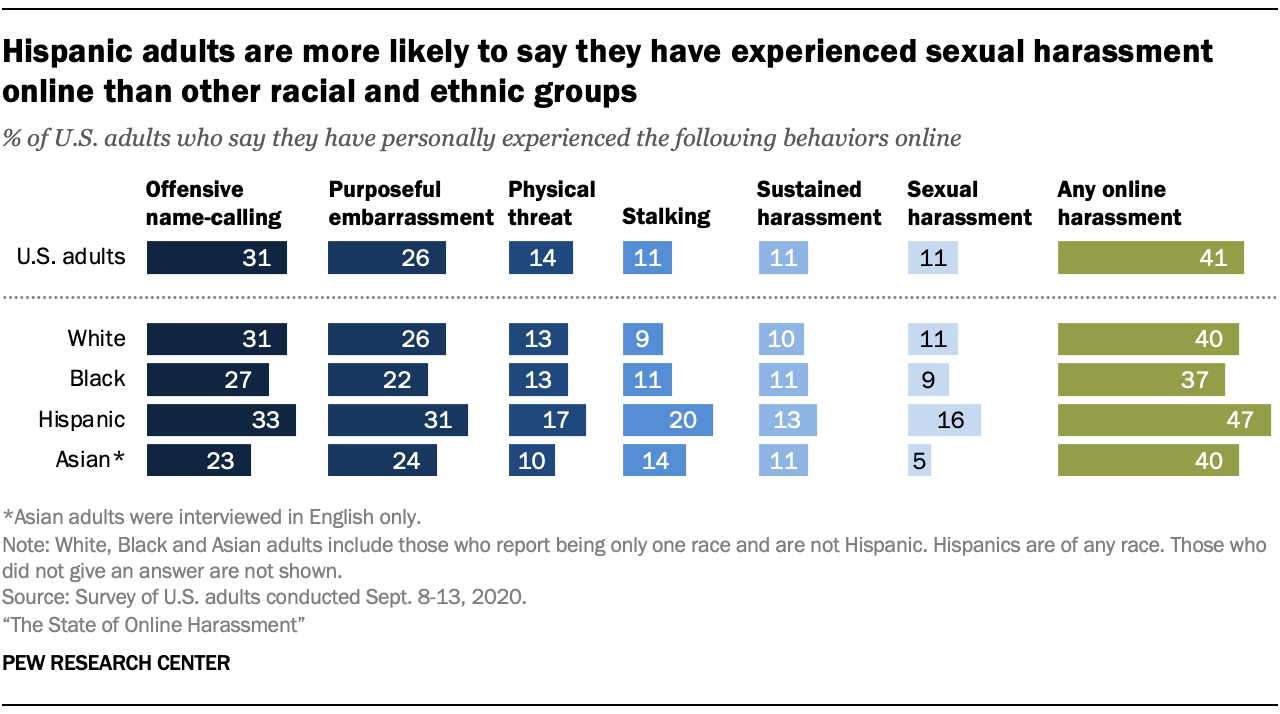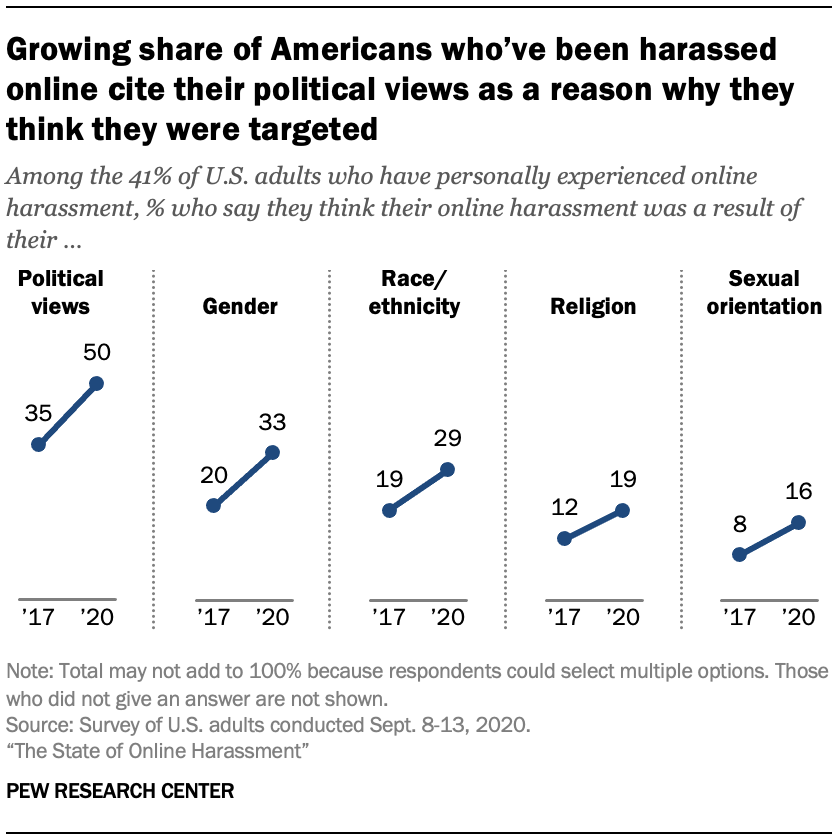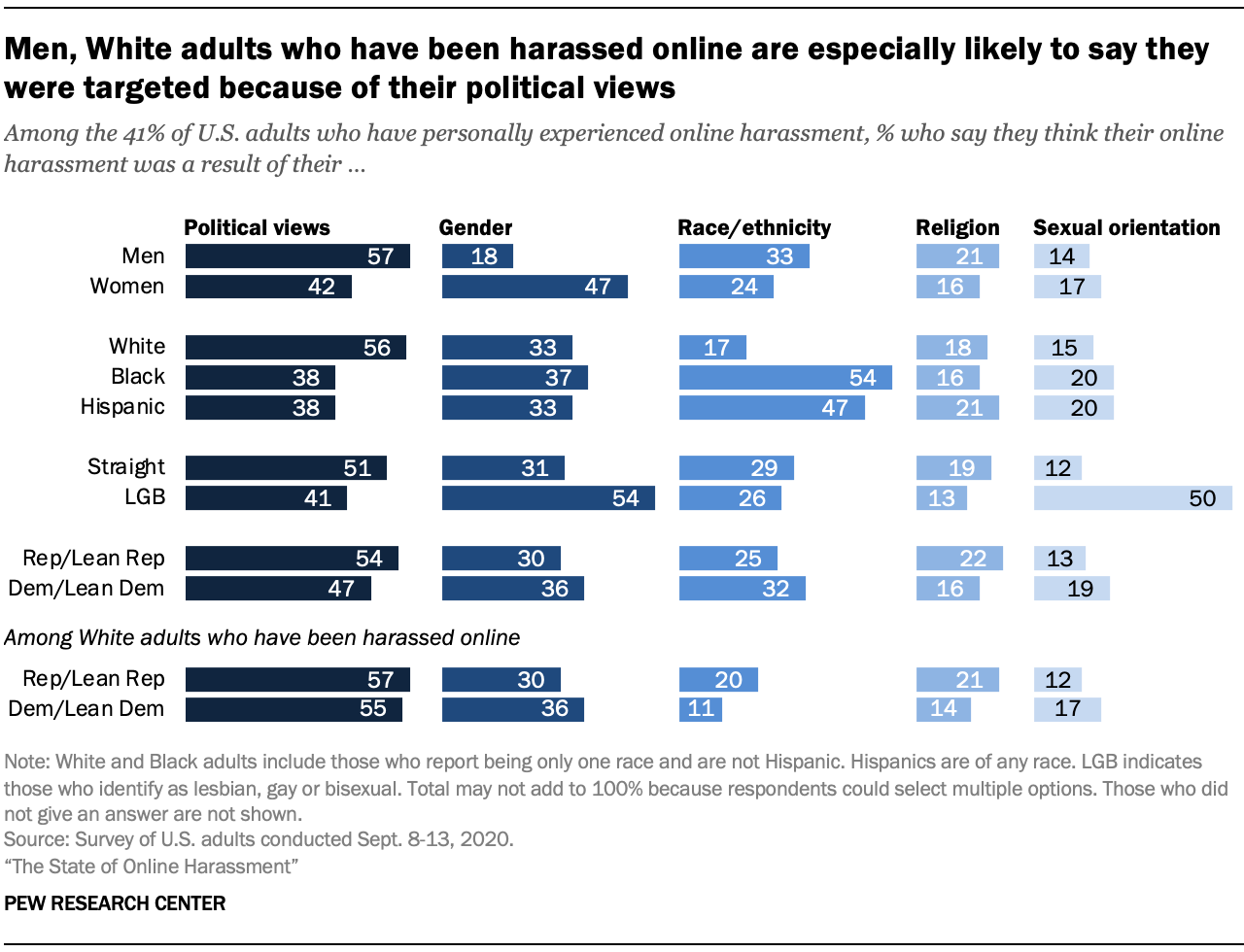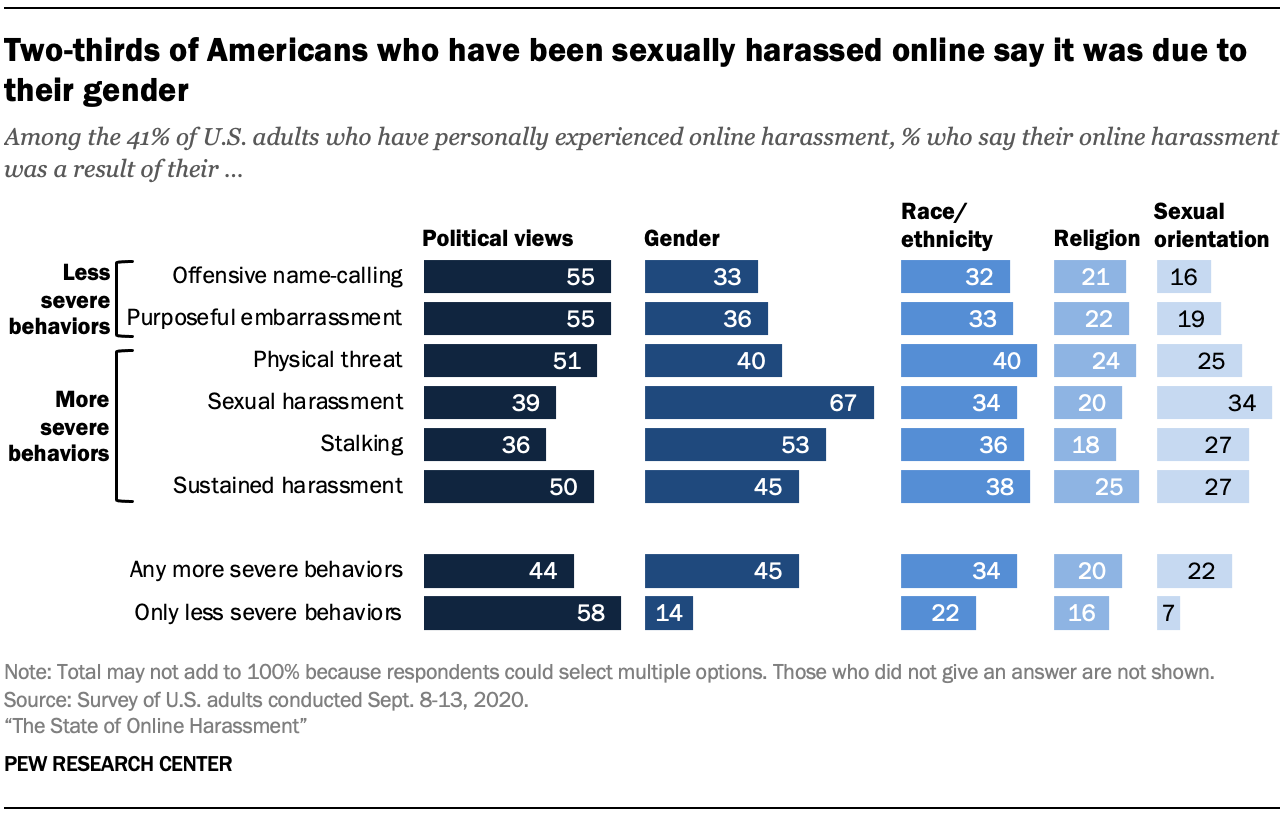Online harassment is a nuanced and complex topic that can involve a multitude of behaviors. This chapter explores Americans’ experiences with six broad types of harassing behaviors, ranging from being called a bad name or purposefully embarrassed to being physically threatened or stalked, in order to capture a broad range of experiences. Overall, the survey shows that the share of U.S. adults who report experiencing any form of online harassment is similar to that found in the Center’s 2017 study. But there are differences when it comes to the shares of adults who have experienced each of the individual harassing behaviors and the shares who have experienced more severe forms of harassment. This chapter also explores the reasons why people think they were targeted for this online abuse. Political views are the most common reason cited overall, but notable demographic differences underlie the reasons people named.
Roughly four-in-ten Americans have personally experienced online harassment
Overall, 41% of Americans have experienced some form of online harassment measured in the latest survey, which is identical to the share who had been the target of online abuse in 2017 and a slight uptick from the 35% in 2014 when the Center first polled on this topic.
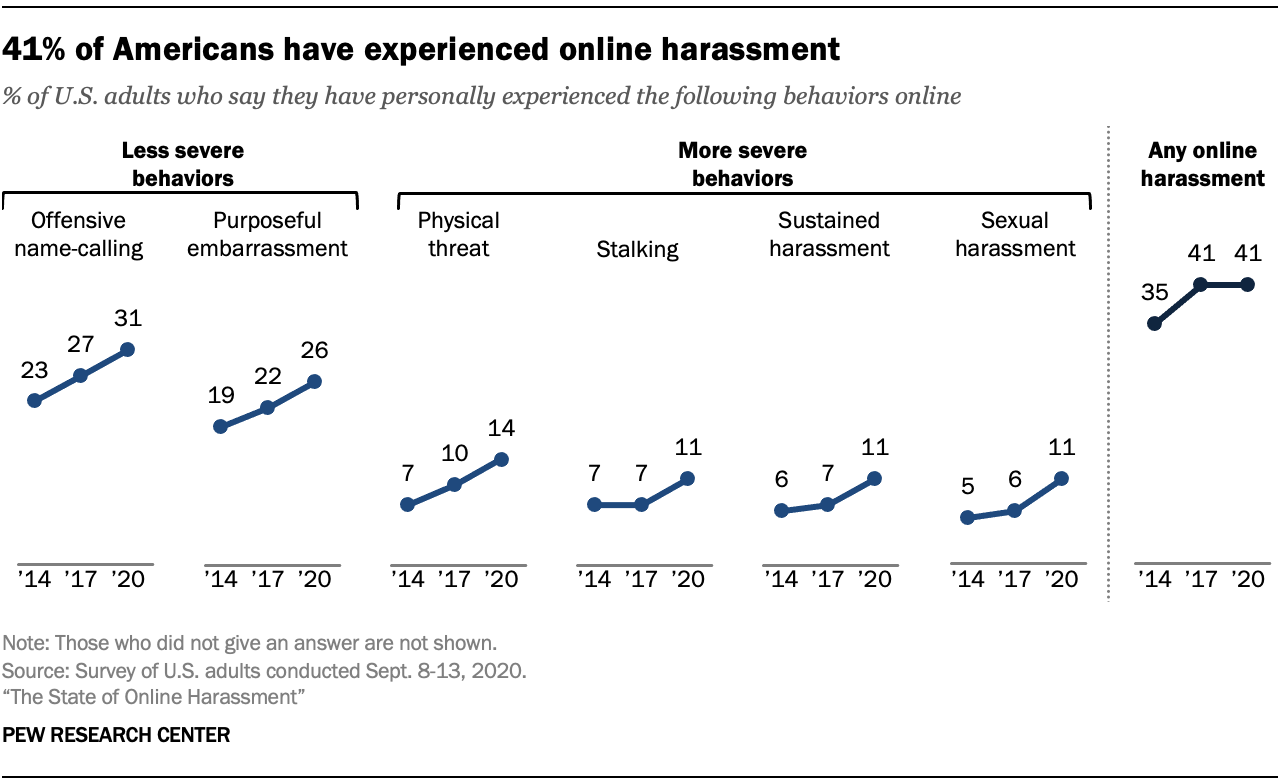
As was true in previous surveys, less severe forms of online abuse – name-calling and purposeful embarrassment – are the most common types of negative experiences reported. Some 31% say they have been called an offensive name online, while 26% report having had someone try to purposefully embarrass them.
At the same time, about one-in-ten or more say they have experienced more severe forms of harassment online, such as being physically threatened (14%), stalked (11%), sexually harassed (11%) or harassed for a sustained period of time (11%).
The share of Americans who say they have experienced at least one of the more severe forms of harassment has been on the rise. One-quarter of adults say they’ve been the target of at least one of these severe forms of online abuse, a share that has increased in each of the Center’s surveys on the issue (from 18% in 2017 and 15% in 2014). Conversely, the share who have experienced either of the less severe behaviors is largely on par with that of 2017 (37% in 2020 vs. 36% in 2017).
Experience with certain types of online abuse varies by age, gender, race or ethnicity
Younger adults are more likely to report having experienced harassment in general as well as more severe forms of harassment. Roughly two-thirds of adults under 30 (64%) say they have experienced any form of online harassment, and 48% say they have faced at least one type of more severe harassment. Roughly half of 30- to 49-year-olds report that they have faced harassment online, while about a third (32%) say they have experienced at least one of the more severe types of harassment. By comparison, much smaller shares of adults 50 and older say the same (26% and 12%, respectively).
Across all six types of online harassment measured in the survey, younger adults are more likely to have been the target of these behaviors online. Fully 51% of adults ages 18 to 29 say they have been called an offensive name online, compared with 37% of those 30 to 49 and 18% of those 50 and older. While very small shares of adults ages 50 and older say they have been physically threatened, sexually harassed, stalked or harassed for a sustained period of time, one-in-five or more adults under 30 and roughly one-in-ten or more adults 30 to 49 have been the target of these behaviors online.
Gender also plays a role in the types of harassment people are likely to encounter online. Overall, men are somewhat more likely than women to say they have experienced any form of harassment online (43% vs. 38%). There are also differences across individual types of negative incidents they have personally encountered online.
To begin with, more men than women say they were called an offensive name (35% vs. 26%) or physically threatened (16% vs. 11%). Women, on the other hand, are more likely than men to report having been sexually harassed online (16% vs. 5%), with young women being particularly likely to have experienced sexual harassment. A third of women under 35 (33%) report having been sexually harassed online, compared with 11% of men under 35. The percentage of women who report having been sexually harassed online has doubled since the Center last asked in early 2017, from 8% to 16%. However, this data cannot parse the reasons as to why this increase has occurred.
Women are more likely than men to report being stalked online (13% vs. 9%), but this difference is more modest in comparison to the difference seen for sexual harassment.
Regardless of differences on individual behaviors, there are no gender differences overall when it comes to having experienced any more severe behaviors.
There are also racial and ethnic differences in people’s experiences with online harassment. About half of Hispanic adults say they have been harassed online, compared with 40% of White adults and 37% of Black adults. (There are no statistical differences between Asian and Hispanic adults.)3
Moreover, Hispanic Americans experience many types of harassment at higher rates than other racial or ethnic groups. In general, Hispanics (33%) are more likely to say they have faced more severe harassment online compared with White (23%), Black (25%) or Asian adults (24%). Specifically, the share of Hispanic adults who report that they have been sexually harassed online is greater than any other racial or ethnic group. They are also more likely to experience being stalked or purposefully embarrassed online compared with Black or White adults. In addition, Hispanic adults are at a somewhat greater likelihood of reporting having been physically threatened than their White or Asian counterparts. About a third of Hispanic (33%) and White adults (31%) say they have been called an offensive name, whereas 23% of Asian adults say the same. The share of Black adults who were called an offensive name did not differ from any of the other racial or ethnic groups.
But in the case of sustained harassment, people’s experiences are somewhat similar across groups. Roughly one-in-ten from each racial or ethnic group say they have undergone harassment for a sustained period of time.
Half of online harassment targets – or one-in-five Americans overall – think the experience was due to their political views
Americans cite a variety of reasons why they encountered harassment online. Half of people who have experienced online harassment (equaling 20% of Americans overall) think they were harassed because of their political views – making this the most common reason cited among the five characteristics asked about in this survey.
At the same time, one-third of those who have been the target of online harassment (14% of all adults) say they have been harassed based on their gender, while 29% say this occurred because of their race or ethnicity (12% of all adults). Smaller shares point to their religion (19% of online harassment targets, representing 8% of U.S. adults overall) or their sexual orientation as a reason for their harassment (16% of online harassment targets, or 7% of all adults).
Each of these reasons has grown more common since the Center last asked these questions in 2017. There has been a 15 percentage point increase in the share of online harassment targets attributing their harassment to their political views; gender has seen a similar rise of 14 points. Race or ethnicity, sexual orientation and religion also rose since 2017.
There are some demographic differences in who points to politics as the reason they were harassed. Indeed, men who have been harassed online are 15 points more likely than women who have been targeted to say this was a result of their political views (57% vs. 42%). There are also large racial and ethnic gaps in citing politics as a perceived catalyst for their abuse: 56% of White adults who have been harassed online say this, compared with 38% each of Black or Hispanic targets.
And while there are some partisan differences, these differences do not hold when accounting for race and ethnicity. For example, White Democrats and Republicans (including independents who lean toward each party) who have been harassed are about equally likely to say their political views were the reason they were harassed (55% vs. 57%). Harassed non-White Democrats and Republicans differ little in believing their harassment experiences were due to politics (39% vs. 43%).
Despite politics being the top-cited reason overall, male (57%) and White online harassment targets (56%) are particularly likely to think their political views were the reason for their online harassment – especially White men (61%). Other groups commonly point to other elements of their identity as the reason they faced harassment online. Roughly half of women who have been harassed online say it was due to their gender, compared with 18% of their male counterparts. Among those who’ve been harassed online, Black (54%) or Hispanic adults (47%) are far more likely than White adults (17%) to identify their race or ethnicity as a reason they were harassed.4
While small shares overall say their harassment was due to their sexual orientation, 50% of online harassment targets who are lesbian, gay or bisexual say they have been harassed online because of their sexual orientation. By comparison, only 12% of straight online harassment targets say the same.
The reason people give for why they were harassed also differs based on the types of harassing behaviors they have experienced. For example, two-thirds (67%) of targets who were sexually harassed say it was due to their gender. Similarly, 53% of people who have been stalked online report gender as a reason they were harassed.
In general, 45% of people who have experienced any of the more severe forms of harassment say their gender contributed to their harassment, while 14% of those who have experienced only less severe behaviors say the same. People who have undergone more severe forms of harassment are also more likely to attribute their experiences to their race or ethnicity (34%) or their sexual orientation (22%), compared with people who have faced only less severe forms of harassment (22% and 7%, respectively). Conversely, people who have dealt only with less severe forms of harassment are more likely to say their experiences were a result of their political views, compared with those who had gone through more severe harassment (58% vs. 44%).


